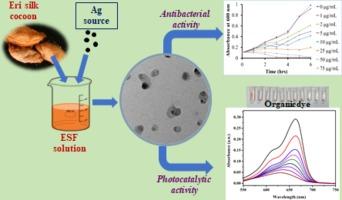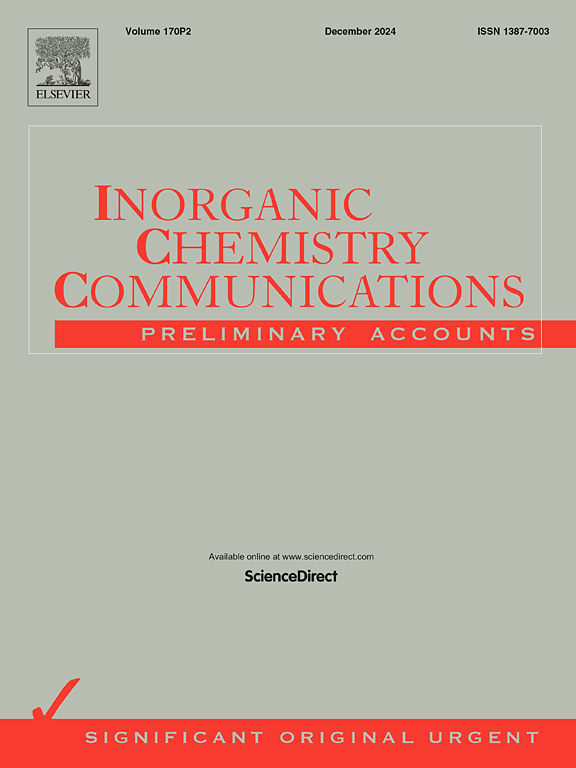Eri silk fibroin derived silver nanoparticles for antibacterial and photocatalytic applications
IF 4.4
3区 化学
Q1 CHEMISTRY, INORGANIC & NUCLEAR
引用次数: 0
Abstract
Silver nanoparticles (AgNPs) are successfully developed using Eri Silk Fibroin. Eri Silk Fibroin, extracted from Eri Silk produced by Eri Silkworm (Samia ricini), has been used as a reducing as well as stabilising agent under green protocol. Formation of AgNPs has been confirmed by the absorbance peak about at 450 nm analysed by UV–vis spectroscopy and also supported by the diffraction peaks at 27.83, 32.15, 38.08, and 46.06⁰ recorded through X-ray diffractometer. FTIR determines the alteration of β-sheet at 1220 cm−1 (amide III), revealing the formation of the AgNPs. Further, TEM analyses the spherical shape of AgNPs with an average particle size of 20 nm. Synthesised AgNPs have been studied for antibacterial activity and photocatalytic degradation of dyes. Five different bacteria were chosen to analyse the impact of ESF@AgNPs on their growth kinetics. Moreover, methylene blue (MB) and congo red (CR) are found to be degraded efficiently to 86 and 88 % in 140 min, respectively. Thus, this research reveals a novel method for the synthesis of AgNPs using Eri Silk Fibroin in the line of sustainable development.

提取自 Eri 丝纤维素的银纳米粒子在抗菌和光催化方面的应用
利用伊丽蚕丝纤维素成功开发出银纳米粒子(AgNPs)。埃里蚕丝纤维素是从埃里蚕(Samia ricini)生产的埃里蚕丝中提取的,在绿色方案下被用作还原剂和稳定剂。通过紫外可见光谱分析 450 纳米波长处的吸光度峰证实了 AgNPs 的形成,通过 X 射线衍射仪记录的 27.83、32.15、38.08 和 46.06⁰处的衍射峰也证明了这一点。傅立叶变换红外光谱(FTIR)确定了 1220 厘米-1(酰胺 III)处 β-片的变化,揭示了 AgNPs 的形成。此外,TEM 分析显示 AgNPs 呈球形,平均粒径为 20 纳米。对合成的 AgNPs 进行了抗菌活性和染料光催化降解研究。研究人员选择了五种不同的细菌来分析 ESF@AgNPs 对其生长动力学的影响。此外,还发现亚甲基蓝(MB)和刚果红(CR)在 140 分钟内分别被有效降解 86% 和 88%。因此,这项研究揭示了一种利用蚕丝纤维素合成 AgNPs 的新方法,符合可持续发展的理念。
本文章由计算机程序翻译,如有差异,请以英文原文为准。
求助全文
约1分钟内获得全文
求助全文
来源期刊

Inorganic Chemistry Communications
化学-无机化学与核化学
CiteScore
5.50
自引率
7.90%
发文量
1013
审稿时长
53 days
期刊介绍:
Launched in January 1998, Inorganic Chemistry Communications is an international journal dedicated to the rapid publication of short communications in the major areas of inorganic, organometallic and supramolecular chemistry. Topics include synthetic and reaction chemistry, kinetics and mechanisms of reactions, bioinorganic chemistry, photochemistry and the use of metal and organometallic compounds in stoichiometric and catalytic synthesis or organic compounds.
 求助内容:
求助内容: 应助结果提醒方式:
应助结果提醒方式:


